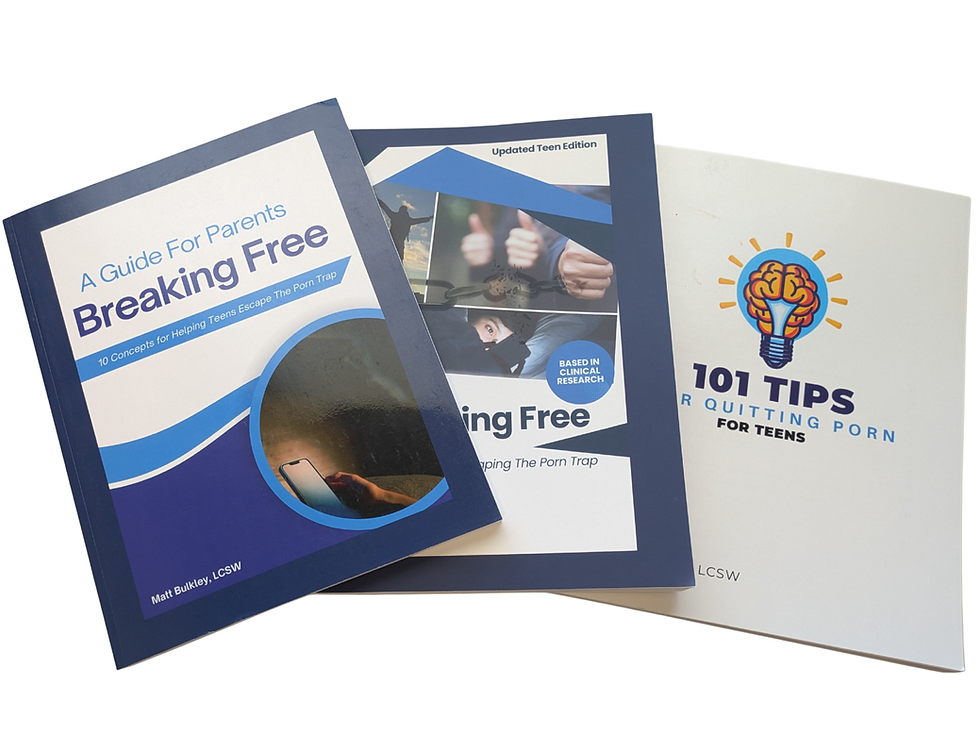Helping Your Teen Overcome Pornography Addiction: The Power of Visualization
- Matt Bulkley

- Jun 25
- 3 min read
As a parent, watching your teen struggle with pornography addiction can feel overwhelming. You want to support them but may not know where to start. One powerful, evidence-based tool that can help is visualization—a technique that empowers teens to imagine themselves free from addiction. This isn’t just a feel-good exercise; it’s backed by science and used by therapists to reduce relapse and build confidence. Here’s how visualization works and how you can guide your teen to use it effectively.
What Is Visualization, and Why Does It Matter?
Visualization is the practice of creating a vivid mental image of a desired outcome—in this case, a life free from pornography addiction. It’s like rehearsing success in your mind. Research shows this technique can reshape the brain through neuroplasticity, its ability to form new neural pathways. A 2022 study in Psychology of Addictive Behaviors found that visualizing positive outcomes strengthens these pathways, making it easier for teens to resist urges. Another 2023 study in Addiction Research & Theory revealed that teens who visualized daily for just five minutes reduced their relapse risk by nearly 50% compared to those who didn’t.
Why is this so effective? When your teen pictures themselves thriving—hanging out with friends, excelling in school, or feeling confident without the pull of pornography—their brain starts to associate those positive feelings with freedom. It’s like giving them a mental roadmap to a healthier life.
How Therapists Use Visualization with Teens
Counselors who specialize in addiction often incorporate visualization into therapy because it’s practical and empowering. They guide teens to close their eyes and imagine specific scenarios where they’re in control: maybe they’re acing a test, laughing at a family dinner, or waking up feeling proud. One therapist described it as “rewriting the brain’s script.” By visualizing these moments, teens learn to recognize triggers—like late-night phone use—and replace them with positive actions they’ve already “rehearsed” in their minds.
This process also boosts self-esteem. When teens see themselves as the hero of their own story, they feel more capable of resisting temptation. It’s not just about avoiding pornography; it’s about building a vision of who they want to be.
How to Help Your Teen Start Visualizing
You don’t need to be a therapist to support your teen in using visualization. Here are simple steps to introduce this tool at home:
Explain the Concept: Share that visualization is like practicing for a big game or performance—it prepares their mind for success. Emphasize that it’s a proven way to stay strong against relapse.
Set a Quiet Moment: Encourage them to try it during a calm time, like before bed or while getting ready in the morning. Even five minutes a day can make a difference.
Guide the Imagery: Suggest they picture a specific moment of freedom. Ask questions like:
What are you doing when you feel proud and in control?
Who are you with? What’s the vibe?
How does it feel to wake up without guilt?
Help them make the scene vivid—details like sounds, smells, or emotions make it more powerful.
Encourage Repetition: Like any skill, visualization gets stronger with practice. Some teens find it helpful to say a quick affirmation, like “This is me thriving,” to lock in the positive feelings.
Be Supportive, Not Pushy: Let them explore this at their own pace. If they’re hesitant, share stories of how athletes or musicians use visualization to succeed, making it feel relatable.
Why Visualization Is a Game-Changer
Visualization does more than help your teen avoid pornography—it builds their confidence and resilience. By picturing a life where they’re in charge, they’re not just escaping addiction; they’re creating a future they’re excited about. This tool also pairs well with other strategies, like therapy, support groups, or healthy hobbies, to keep them on track.
A Final Note for Parents
Supporting a teen through addiction is tough, but you’re not alone. Visualization is a simple, accessible way to empower your teen to take control of their journey. Encourage them to try it, celebrate their efforts, and keep open lines of communication. If you’re looking for more resources, consider exploring professional support. Learn more about our Resources for teen pornography addiction.
By helping your teen visualize a brighter, addiction-free future, you’re giving them a powerful tool to rewrite their story—one where they’re the confident, thriving person they’re meant to be.










Comments